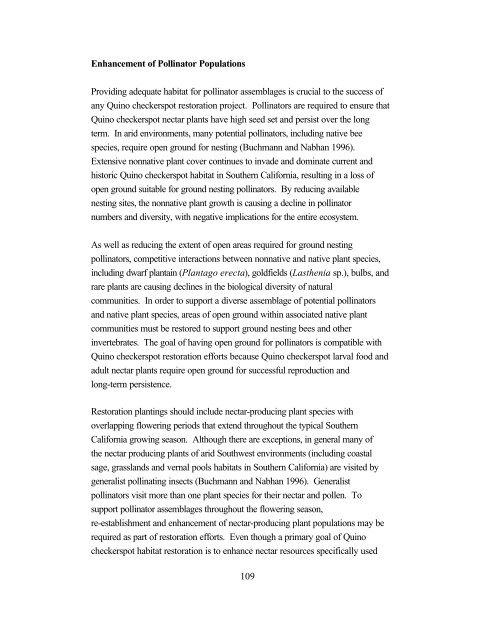Outline of Quino Recovery Plan - The Xerces Society
Outline of Quino Recovery Plan - The Xerces Society
Outline of Quino Recovery Plan - The Xerces Society
Create successful ePaper yourself
Turn your PDF publications into a flip-book with our unique Google optimized e-Paper software.
Enhancement <strong>of</strong> Pollinator Populations<br />
Providing adequate habitat for pollinator assemblages is crucial to the success <strong>of</strong><br />
any <strong>Quino</strong> checkerspot restoration project. Pollinators are required to ensure that<br />
<strong>Quino</strong> checkerspot nectar plants have high seed set and persist over the long<br />
term. In arid environments, many potential pollinators, including native bee<br />
species, require open ground for nesting (Buchmann and Nabhan 1996).<br />
Extensive nonnative plant cover continues to invade and dominate current and<br />
historic <strong>Quino</strong> checkerspot habitat in Southern California, resulting in a loss <strong>of</strong><br />
open ground suitable for ground nesting pollinators. By reducing available<br />
nesting sites, the nonnative plant growth is causing a decline in pollinator<br />
numbers and diversity, with negative implications for the entire ecosystem.<br />
As well as reducing the extent <strong>of</strong> open areas required for ground nesting<br />
pollinators, competitive interactions between nonnative and native plant species,<br />
including dwarf plantain (<strong>Plan</strong>tago erecta), goldfields (Lasthenia sp.), bulbs, and<br />
rare plants are causing declines in the biological diversity <strong>of</strong> natural<br />
communities. In order to support a diverse assemblage <strong>of</strong> potential pollinators<br />
and native plant species, areas <strong>of</strong> open ground within associated native plant<br />
communities must be restored to support ground nesting bees and other<br />
invertebrates. <strong>The</strong> goal <strong>of</strong> having open ground for pollinators is compatible with<br />
<strong>Quino</strong> checkerspot restoration efforts because <strong>Quino</strong> checkerspot larval food and<br />
adult nectar plants require open ground for successful reproduction and<br />
long-term persistence.<br />
Restoration plantings should include nectar-producing plant species with<br />
overlapping flowering periods that extend throughout the typical Southern<br />
California growing season. Although there are exceptions, in general many <strong>of</strong><br />
the nectar producing plants <strong>of</strong> arid Southwest environments (including coastal<br />
sage, grasslands and vernal pools habitats in Southern California) are visited by<br />
generalist pollinating insects (Buchmann and Nabhan 1996). Generalist<br />
pollinators visit more than one plant species for their nectar and pollen. To<br />
support pollinator assemblages throughout the flowering season,<br />
re-establishment and enhancement <strong>of</strong> nectar-producing plant populations may be<br />
required as part <strong>of</strong> restoration efforts. Even though a primary goal <strong>of</strong> <strong>Quino</strong><br />
checkerspot habitat restoration is to enhance nectar resources specifically used<br />
109
















